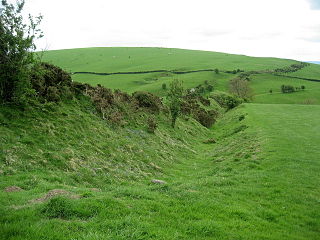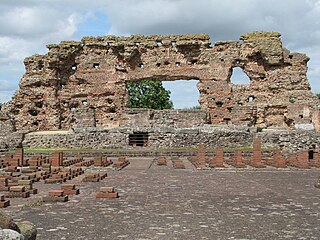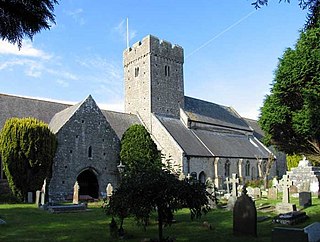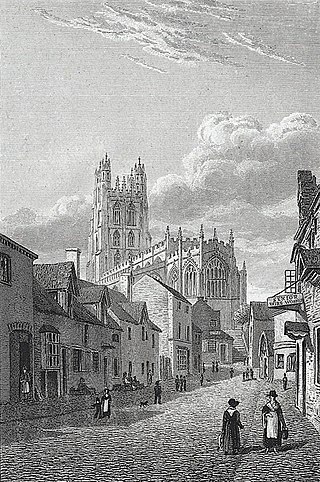
Offa's Dyke is a large linear earthwork that roughly follows the border between England and Wales. The structure is named after Offa, the Anglo-Saxon king of Mercia from AD 757 until 796, who is traditionally believed to have ordered its construction. Although its precise original purpose is debated, it delineated the border between Anglian Mercia and the Welsh kingdom of Powys.

Hywel ap Cadell, commonly known as Hywel Dda, which translates to Howel the Good in English, was a Welsh king who ruled the southern Welsh kingdom of Deheubarth and eventually came to rule most of Wales. He became the sole king of Seisyllwg in 920 and shortly thereafter established Deheubarth, and proceeded to gain control over the entire country from Prestatyn to Pembroke. As a descendant of Rhodri Mawr through his father Cadell, Hywel was a member of the Dinefwr branch of the dynasty. He was recorded as King of the Britons in the Annales Cambriæ and the Annals of Ulster.

Vortigern, also spelled Vortiger, Vortigan, Voertigern and Vortigen, was a 5th-century warlord in Britain, known perhaps as a king of the Britons or at least connoted as such in the writings of Bede and Gildas. His existence is contested by scholars and information about him is obscure.

Watling Street is a historic route in England that crosses the River Thames at London and which was used in Classical Antiquity, Late Antiquity, and throughout the Middle Ages. It was used by the ancient Britons and paved as one of the main Roman roads in Britannia. The route linked Dover and London in the southeast, and continued northwest via St Albans to Wroxeter. The line of the road was later the southwestern border of the Danelaw with Wessex and Mercia, and Watling Street was numbered as one of the major highways of medieval England.

Germanus of Auxerre was a western Roman clergyman who was bishop of Autissiodorum in Late Antique Gaul. He abandoned a career as a high-ranking government official to devote his formidable energy towards the promotion of the church and the protection of his "flock" in dangerous times, personally confronting, for instance, the barbarian king "Goar". In Britain he is best remembered for his journey to combat Pelagianism in or around 429 AD, and the records of this visit provide valuable information on the state of post-Roman British society. He also played an important part in the establishment and promotion of the Cult of Saint Alban. The saint was said to have revealed the story of his martyrdom to Germanus in a dream or holy vision, and Germanus ordered this to be written down for public display. Germanus is venerated as a saint in both the Roman Catholic and Orthodox churches, which commemorate him on 31 July.

The Cornovīī were a Celtic people of the Iron Age and Roman Britain, who lived principally in the modern English counties of Cheshire, Shropshire, north Staffordshire, north Herefordshire and eastern parts of the Welsh counties of Flintshire, Powys and Wrexham. Their capital in pre-Roman times was probably a hillfort on the Wrekin. Ptolemy's 2nd-century Geography names two of their towns: Deva Victrix (Chester) and Viroconium Cornoviorum (Wroxeter), which became their capital under Roman rule.

Cunedda ap Edern, also called Cunedda Wledig, was an important early Welsh leader, and the progenitor of the Royal dynasty of Gwynedd, one of the very oldest of Western Europe.

Viroconium or Uriconium, formally Viroconium Cornoviorum, was a Roman city, one corner of which is now occupied by Wroxeter, a small village in Shropshire, England, about 5 miles (8 km) east-south-east of Shrewsbury. At its peak, Viroconium is estimated to have been the 4th-largest Roman settlement in Britain, a civitas with a population of more than 15,000. The settlement probably lasted until the end of the 7th century or the beginning of the 8th. Extensive remains can still be seen.

The Kingdom of Powys was a Welsh successor state, petty kingdom and principality that emerged during the Middle Ages following the end of Roman rule in Britain. It very roughly covered the northern two-thirds of the modern county of Powys and part of today's English West Midlands. More precisely, and based on the Romano-British tribal lands of the Ordovices in the west and the Cornovii in the east, its boundaries originally extended from the Cambrian Mountains in the west to include the modern West Midlands region of England in the east. The fertile river valleys of the Severn and Tern are found here, and this region is referred to in later Welsh literature as "the Paradise of Powys".

Wroxeter is a village and former civil parish, now in the parish of Wroxeter and Uppington, in the Shropshire district, in the ceremonial county of Shropshire, England. It is beside the River Severn, 5 miles (8.0 km) south-east of Shrewsbury. In 1961 the parish had a population of 657.

Sub-Roman Britain is the period of late antiquity in Great Britain between the end of Roman rule and the Anglo-Saxon settlement. The term was originally used to describe archaeological remains found in 5th- and 6th-century AD sites that hinted at the decay of locally made wares from a previous higher standard under the Roman Empire. It is now used to describe the period that commenced with the recall of Roman troops to Gaul by Constantine III in 407 and to have concluded with the Battle of Deorham in 577.

St Illtyd's Church is a church complex in Llantwit Major, Vale of Glamorgan, southeast Wales. It is located at the site of the oldest college in the United Kingdom, once believed to have been founded as Côr Tewdws c. AD 395 by the Roman Emperor Theodosius II. It is now generally accepted as having been founded by St. Illtud c. AD 508, from whom it derives its name. The current church building was built in the 11th century by the Normans, with portions being rebuilt in the 13th and 15th centuries. The church building is one of the oldest and best-known parish churches in Wales. It is a grade I listed building, or building of exceptional interest, and has been called both the "Westminster Abbey of Wales" for its unique collection of carved stones and effigies, and "the most beautiful church in Wales."

Pengwern was a Brythonic settlement of sub-Roman Britain situated in what is now the English county of Shropshire, adjoining the modern Welsh border. It is regarded as possibly being the early seat of the kings of Powys before its establishment at Mathrafal, further west, but the theory that it was an early kingdom has also been postulated. Its precise location is uncertain.

Mathrafal near Welshpool, in Powys, Mid Wales, was the seat of the Kings and Princes of Powys probably from the 9th century until its destruction in 1213 by Prince Llywelyn the Great.
Cadell or Cadel is an old Welsh personal name derived from the Latin Catullus. As a surname, it derives from the Welsh patronymic "ap Cadell". Notable people with the name include:
Cyngen Glodrydd was an early 6th-century King of Powys. He was a descendant of King Cadell Ddyrnllwg. Cyngen married St. Tudlwystl, a daughter of Brychan ap Gwyngwen ap Tewdr and they were parents of a large family: Brochfael Ysgithrog, Cadell, Ieuaf, Maig Myngfras, Mawn and Sanan. What is probably his memorial stone was discovered being used as a gatepost in Tywyn (Gwynedd) in 1761. He was apparently buried with St. Cadfan in the local churchyard.

The city of Wrexham in north-east Wales has a history dating back to ancient times. The former market town was the site of heavy industry in the 19th and 20th centuries, and is now an active commercial centre. Wrexham was granted city status in 2022.

Ial or Yale was a commote of medieval Wales within the cantref of Maelor in the Kingdom of Powys. When the Kingdom was divided in 1160, Maelor became part of the Princely realm of Powys Fadog, and belonged to the Royal House of Mathrafal. Yale eventually merged with another commote and became the Lordship of Bromfield and Yale, later a royal lordship under the Tudors and Stuarts.

The Royal House of Mathrafal began as a cadet branch of the Welsh Royal House of Dinefwr, taking their name from Mathrafal Castle. They effectively replaced the House of Gwertherion, who had been ruling the Kingdom of Powys since late Roman Britain, through the politically advantageous marriage of an ancestor, Merfyn the Oppressor. King Bleddyn ap Cynfyn would join the resistance of the Anglo-Saxon King Harold Godwinson, against the invasion of William the Conqueror, following the Norman conquest of England. Thereafter, they would struggle with the Plantagenets and the remaining Welsh Royal houses for the control of Wales. Although their fortunes rose and fell over the generations, they are primarily remembered as Kings of Powys and last native Prince of Wales.
















